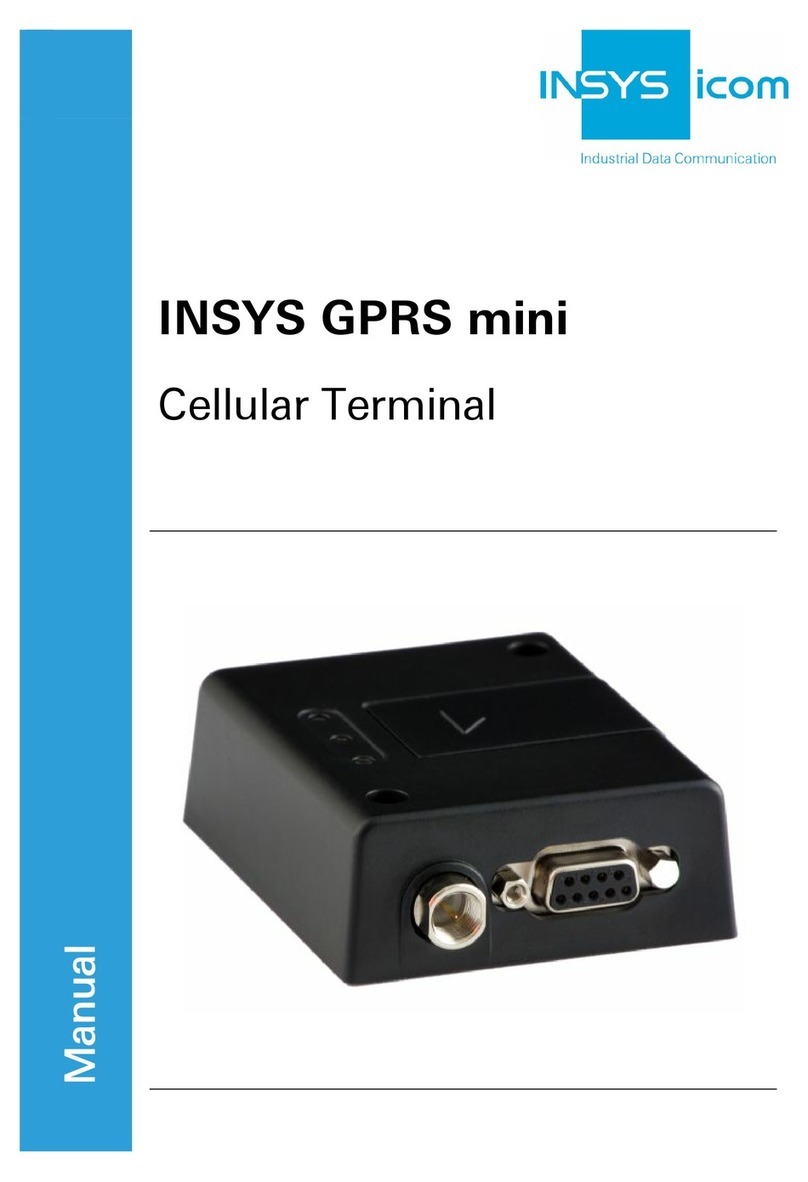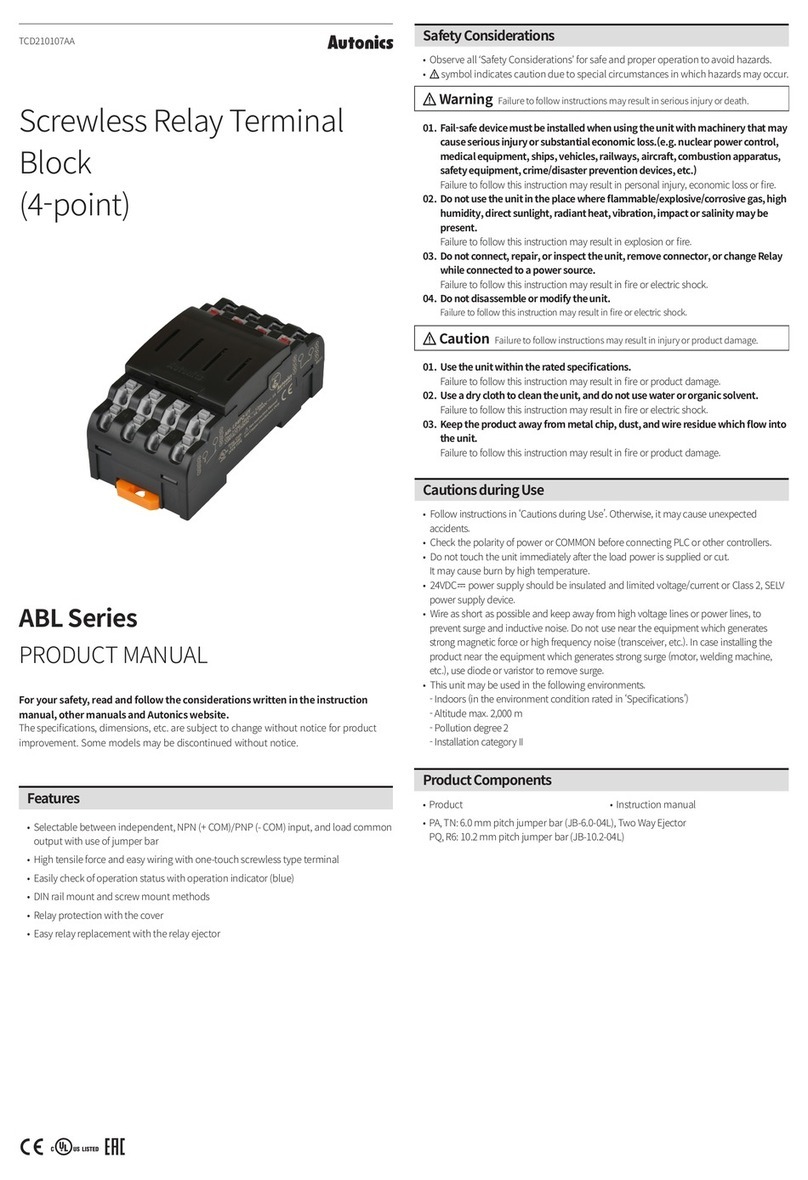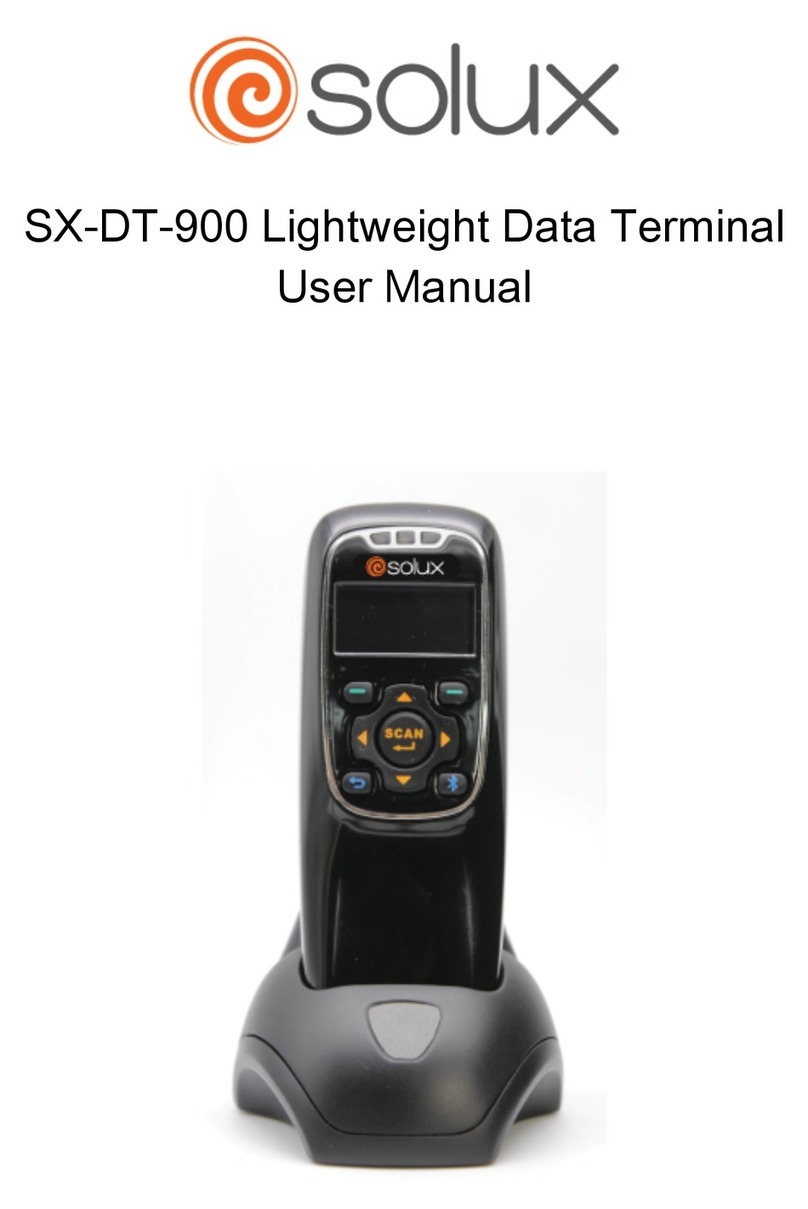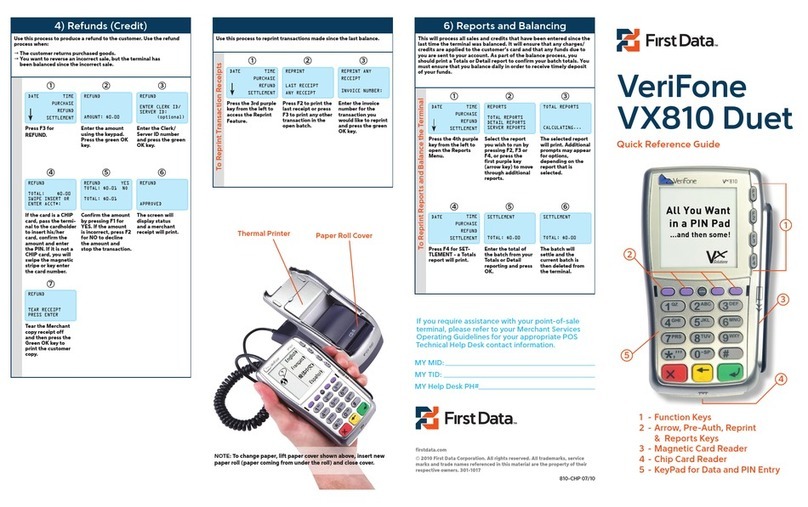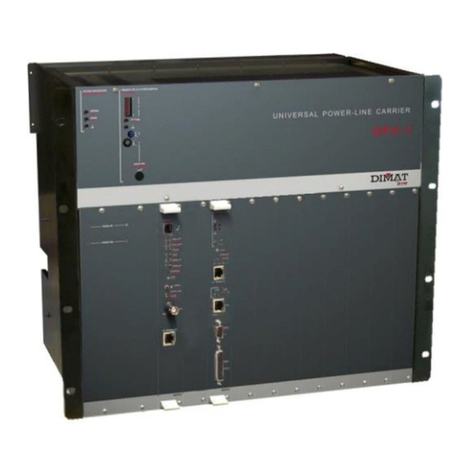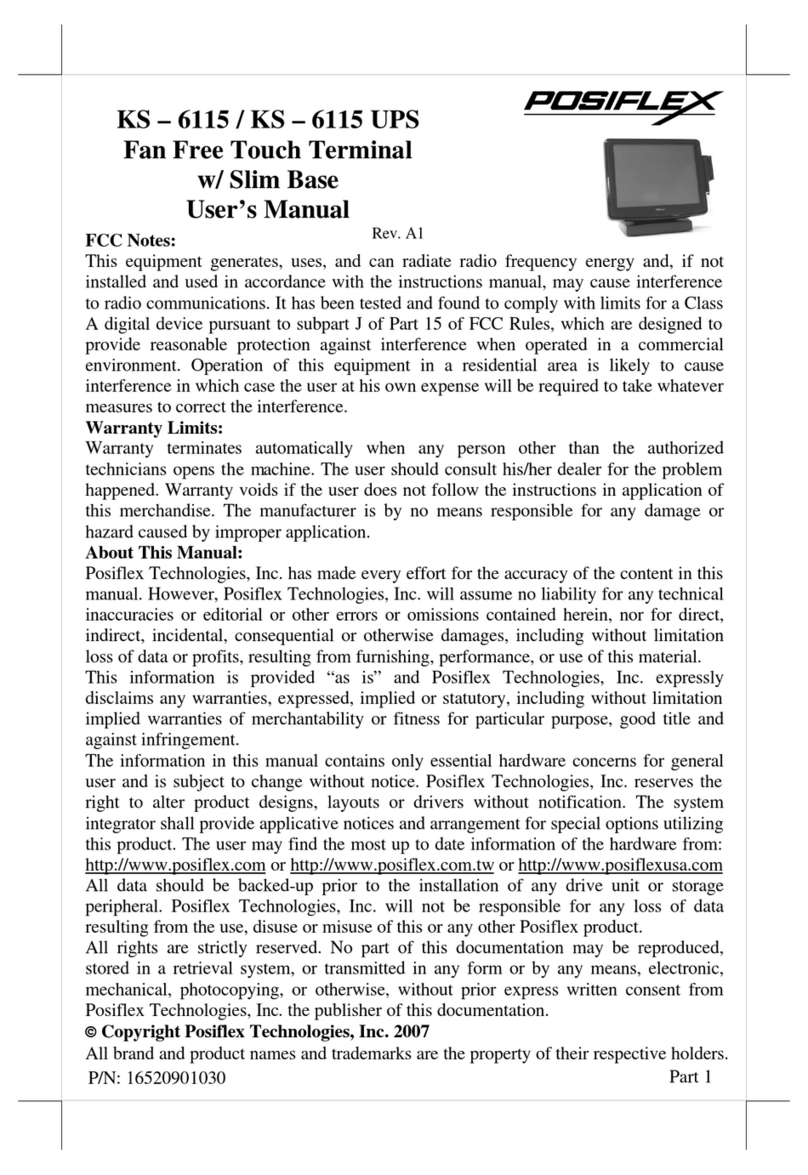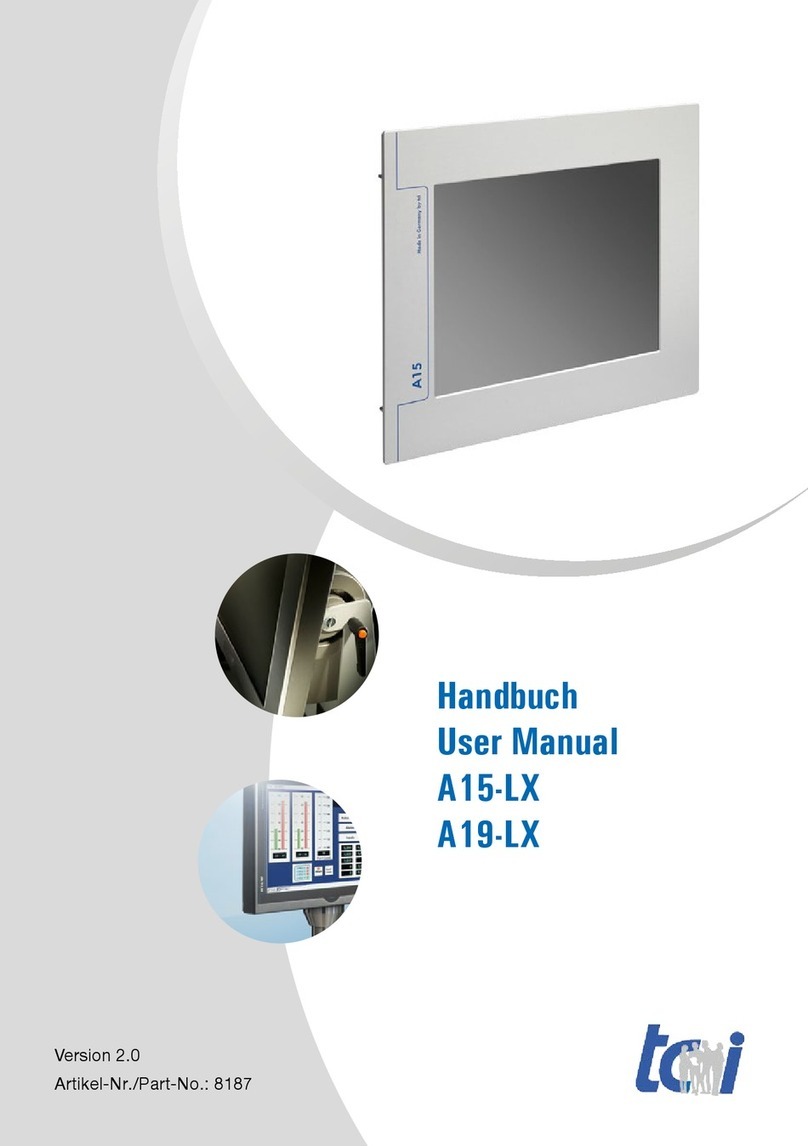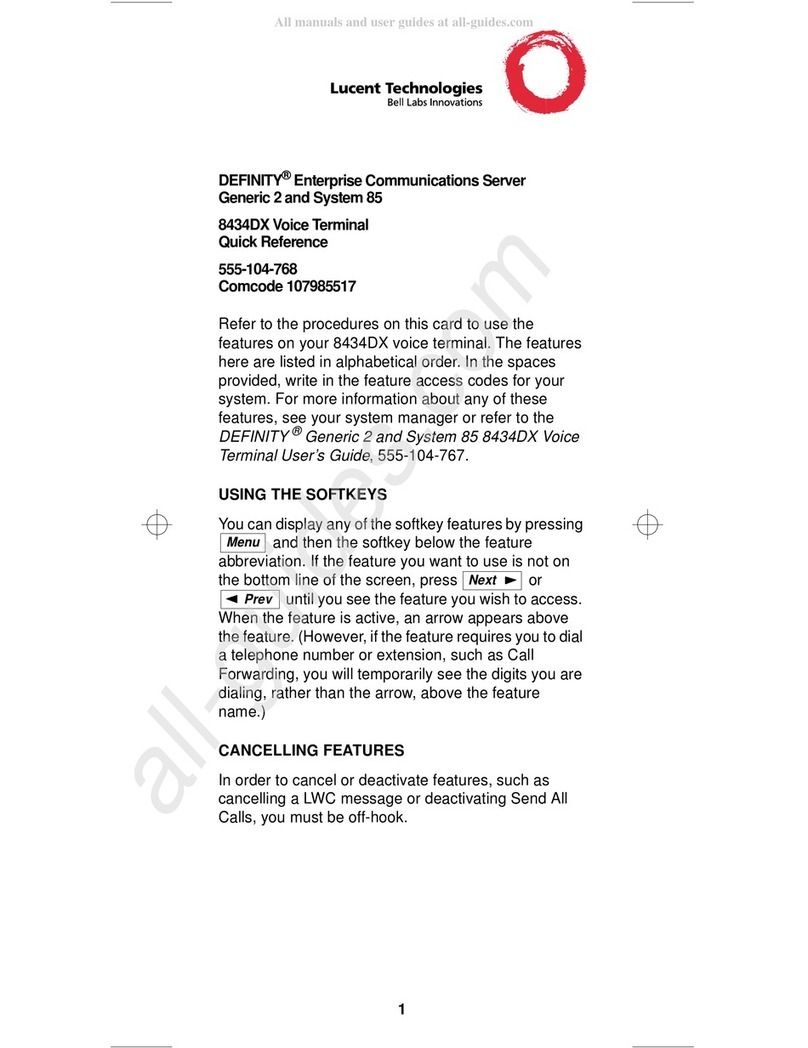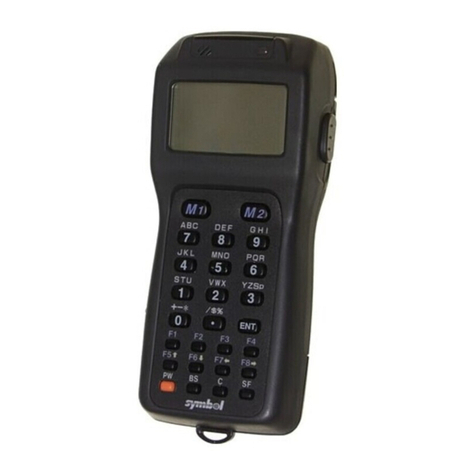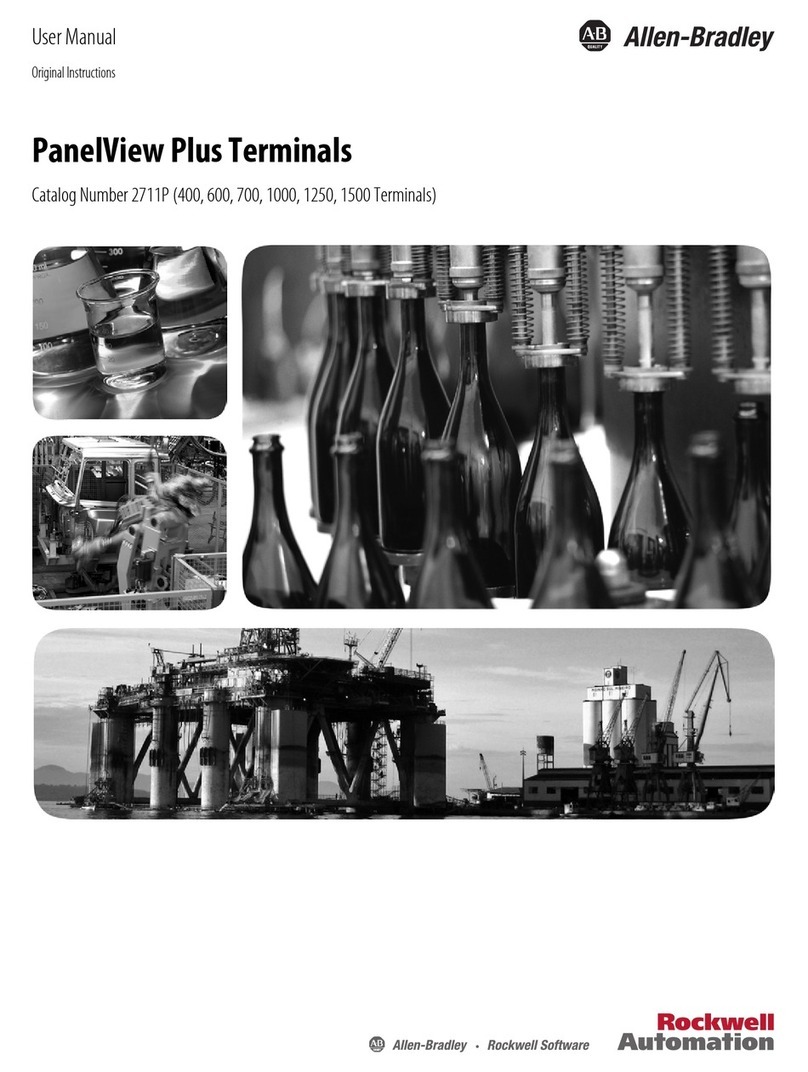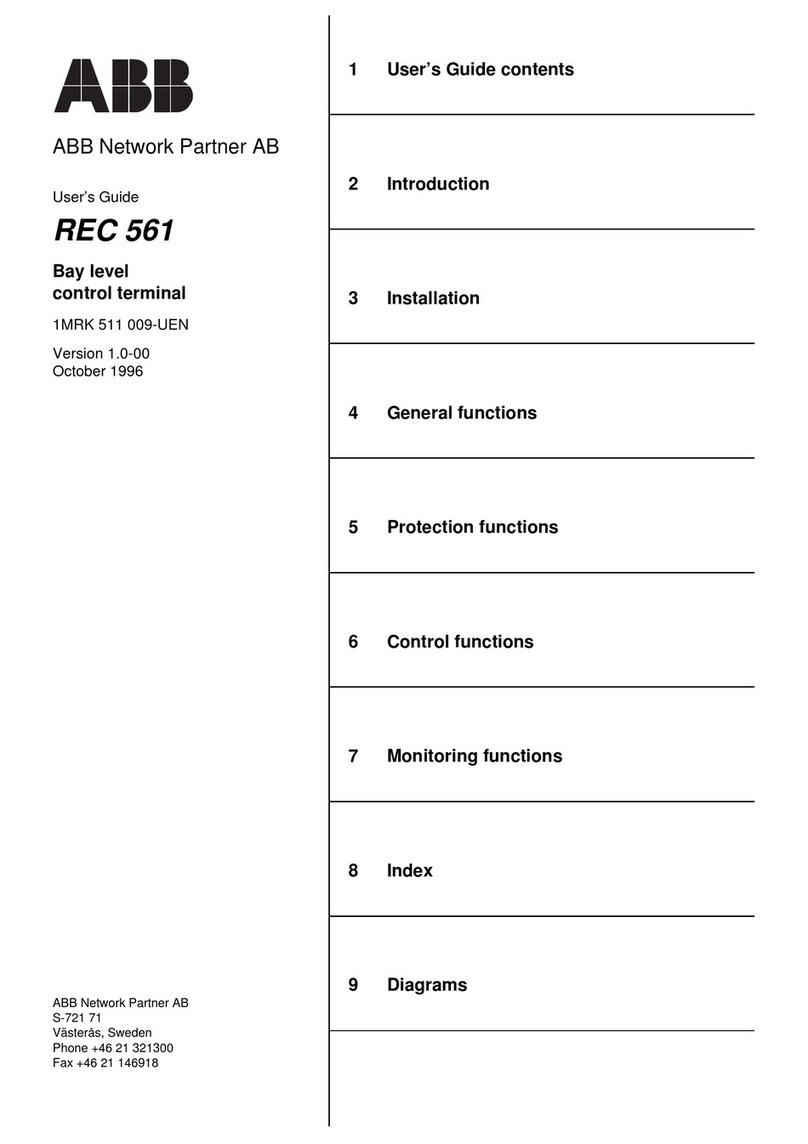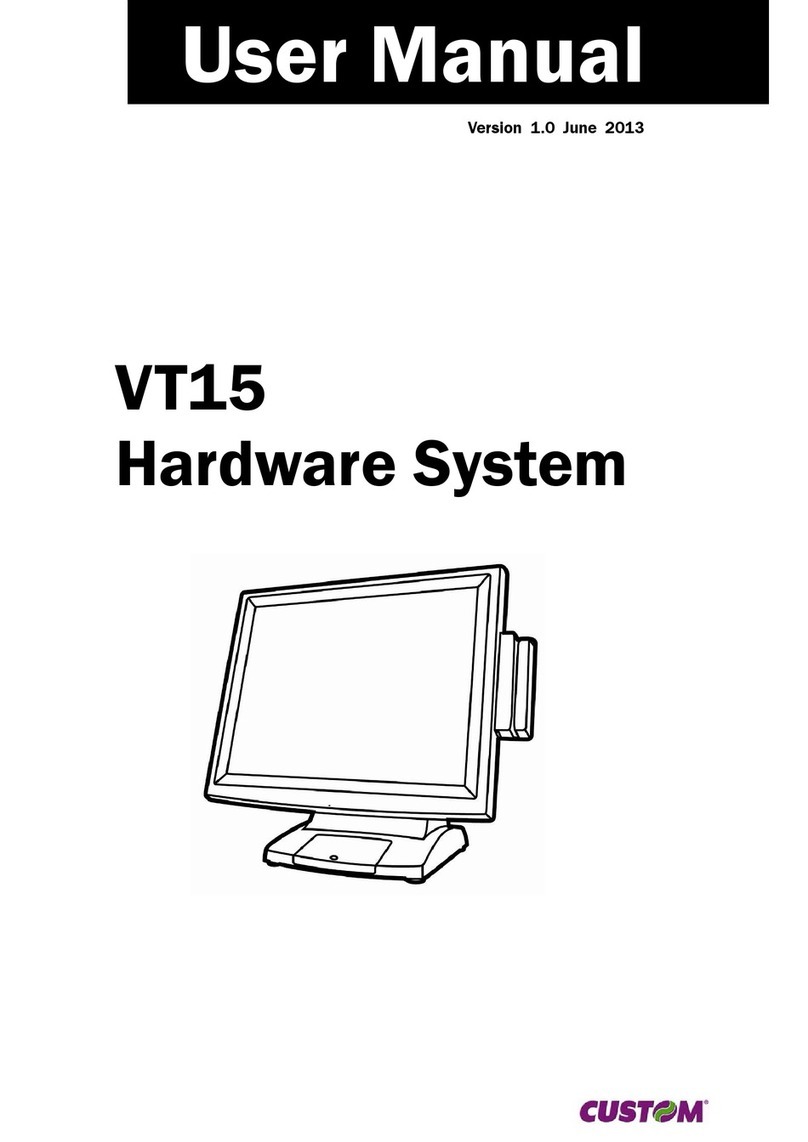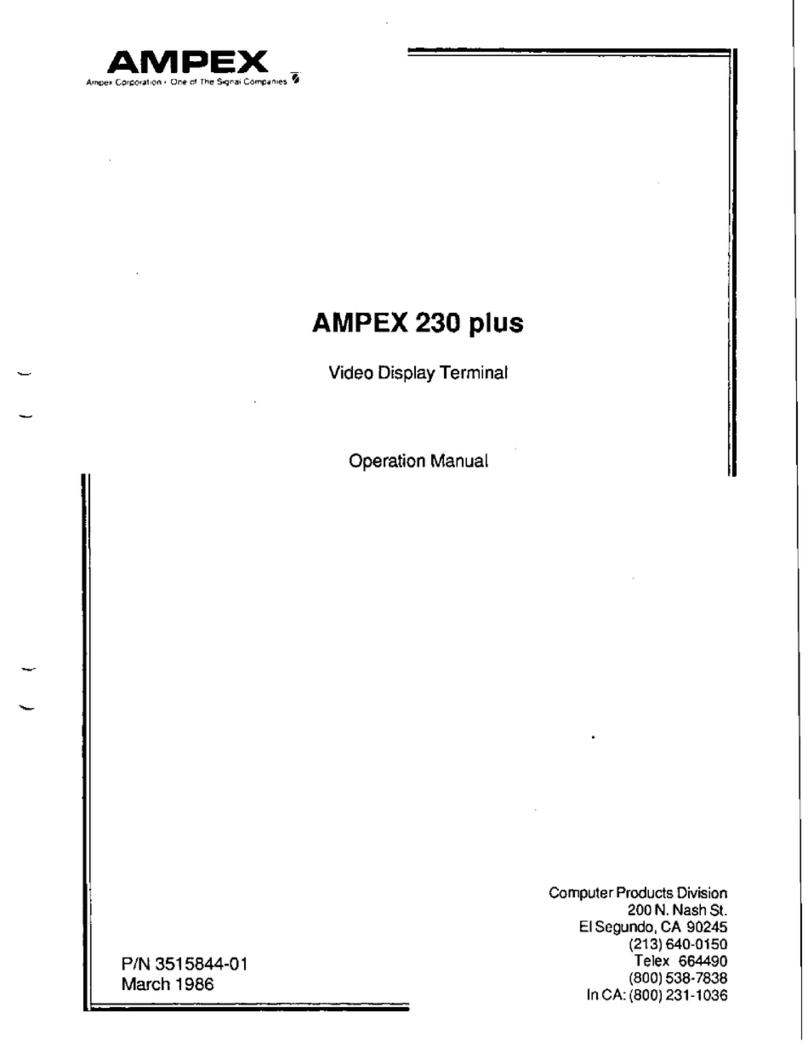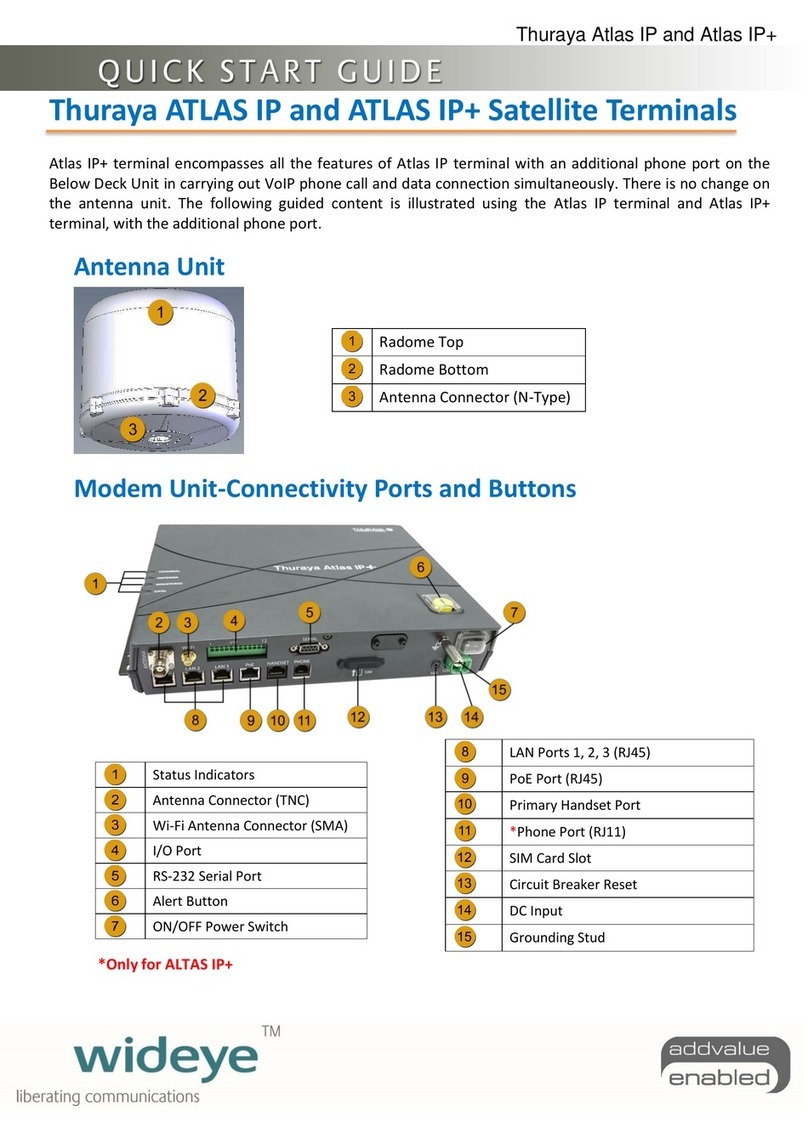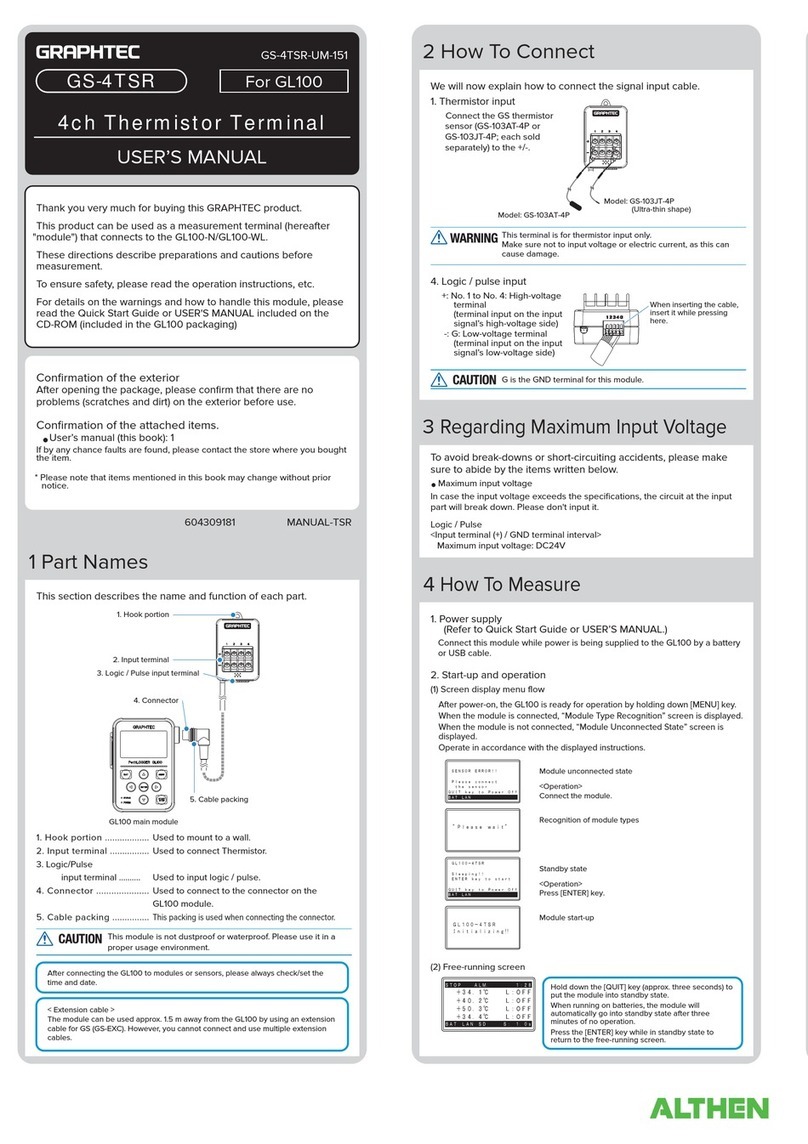insys icom GSM small 2.0 User manual

Manual
INSYS GSM small 2.0


Copyright © February 12 INSYS MICROELECTRONICS GmbH
Any duplication of this manual is prohibited. All rights on this documentation and
the devices are with INSYS MICROELECTRONICS GmbH Regensburg.
Trademarks
The use of a trademark not shown below is not an indication that it is freely avail-
able for use.
MNP is a registered trademark of Microcom Inc.
IBM PC, AT, XT are registered trademarks of International Business Machine Cor-
poration.
INSYS®, e-Mobility LSG® and e-Mobility PLC® are registered trademarks of INSYS
MICROELECTRONICS GmbH.
Windows™ is a registered trademark of Microsoft Corporation.
Linux is a registered trademark of Linus Torvalds.
Publisher:
INSYS MICROELECTRONICS GmbH
Hermann-Köhl-Str. 22
D-93049Regensburg, Germany
Phone: +49 941 58692-0
Fax: +49 941 58692-45
E-mail: info@insys-icom.com
Internet: http://www.insys-icom.com
Date: Feb-12
Item: 31-22-03.167
Version: 1.1
Language: EN

Content
1Preface.....................................................................................................7
1.1 Defects Liability Terms ..........................................................................................7
1.2 Marking of Warnings and Notes............................................................................8
1.2.1 Symbols and Key Words .......................................................................... 8
1.3 Symbols and the Formatting in this Manual ..........................................................9
2Safety.....................................................................................................10
2.1 Usage According to the Regulations ...................................................................10
2.2 Permissible Technical Limits................................................................................11
2.3 Responsibilities of the Operator...........................................................................11
2.4 Qualification of the Personnel..............................................................................11
2.5 Instructions for Transport and Storage ................................................................11
2.6 Markings on the Product .....................................................................................12
2.7 Environmental Protection ....................................................................................12
2.8 Safety Instructions for Electrical Installation........................................................13
2.9 General Safety Instructions..................................................................................13
3Scope of Delivery...................................................................................15
4Technical Data .......................................................................................16
4.1 Physical Features.................................................................................................16
4.2 Technological Features........................................................................................17
5Display and Control Elements ................................................................18
5.1 Display Elements .................................................................................................18
5.2 Control Elements .................................................................................................20
6Connections...........................................................................................21
6.1 Front Panel Connections......................................................................................21
6.2 Terminal Connections on the Top ........................................................................22
6.3 Terminal Connections on the Bottom ..................................................................22
6.4 Pin Assignment of the Serial Interface.................................................................23
7Function Overview .................................................................................24
8Mounting ...............................................................................................26
9Initial Operation......................................................................................30
10 Operating Principle ................................................................................32
10.1 Operation with the Terminal Program..................................................................32
10.2 Operation with HSComm GSM/GPRS..................................................................33
4Feb-12

Contents
11 Functions ...............................................................................................35
11.1 Entering the PIN of the SIM Card ........................................................................35
11.2 Insert and Remove SIM Card...............................................................................36
11.3 Checking the Status of the GSM Login................................................................38
11.4 Checking the GSM Signal Quality........................................................................39
11.5 Automatic baud rate detection ............................................................................40
11.5.1 Serial Connection ................................................................................... 40
11.5.2 Phone connection .................................................................................. 41
11.6 Data Flow Control (Handshake) ...........................................................................42
11.6.1 Hardware Data Flow Control (RTS/CTS)................................................. 42
11.6.2 Software Data Flow Control (XON/XOFF) .............................................. 42
11.7 Establishing or Accepting a CSD Data Connection..............................................44
11.8 Establishing a PPP Data Connection....................................................................45
11.9 Automatic call acceptance...................................................................................46
11.10 Sending an SMS Manually ..................................................................................47
11.11 Automatic execution of AT commands................................................................48
11.11.1 Automated PIN entry and login after restart .......................................... 49
11.11.2 Automatic reset...................................................................................... 50
11.11.3 Alarm via DTR Control Line.................................................................... 51
11.12 Configuration of Energy Conservation Modes and Real-Time Clock....................54
11.12.1 Real time clock ....................................................................................... 54
11.12.2 Change Between the Energy Conservation Modes ............................... 56
11.12.3 Sleep Modes........................................................................................... 57
11.12.4 Power-Down Mode ................................................................................ 59
11.12.5 Shutdown mode..................................................................................... 61
11.13 Operation with a PLC...........................................................................................61
11.14 Using USSD Codes..............................................................................................62
11.15 Resetting the Device............................................................................................62
12 AT Command Reference........................................................................63
12.1 General Information to the Command Sets .........................................................63
12.2 Short Description AT Commands ........................................................................64
12.2.1 AT Commands According to V.250 ....................................................... 65
12.2.2 AT Commands for GSM Connections .................................................... 69
12.2.3 AT Commands for SMS ......................................................................... 71
12.2.4 AT Commands for GPRS Connections................................................... 72
12.2.5 AT Commands for Energy Conservation Functions ............................... 78
12.2.6 AT Commands for Time Functions ........................................................ 79
12.2.7 AT Commands for Automatic Functions................................................ 79
13 GSM Service Center Numbers ...............................................................80
14 APN Access Data...................................................................................81
15 Network Provider Codes ........................................................................82
Feb-12 5

Content
6Feb-12
16 Maintenance, Repair and Troubleshooting.............................................83
16.1 Maintenance........................................................................................................83
16.2 Troubleshooting...................................................................................................83
16.3 Repair ..................................................................................................................83
17 Waste Disposal ......................................................................................84
17.1 Repurchasing of Legacy Systems........................................................................84
18 Declaration of Conformity......................................................................85
19 Tables and Diagrams..............................................................................86
19.1 List of Tables .......................................................................................................86
19.2 List of Diagrams ..................................................................................................86
20 Index......................................................................................................87

INSYS GSM small 2.0 Preface
1Preface
This manual allows for the safe and efficient use of the product. The manual is part
of the product and must always be stored accessible for installation, commission-
ing and operating personnel.
1.1 Defects Liability Terms
A usage not according to the intended purpose, an ignorance of this documenta-
tion, the use of insufficiently qualified personnel as well as unauthorised modifica-
tions exclude the liability of the manufacturer for damages resulting from this. The
liability of the manufacturer ceases to exist.
The regulations of our Delivery and Purchasing Conditions are effective. These can
be found on our website (www.insys-icom.de/imprint/) under “General Terms and
Conditions“.
7

Preface INSYS GSM small 2.0
1.2 Marking of Warnings and Notes
1.2.1 Symbols and Key Words
Danger!
Risk of severe or fatal injury
One of these symbols in conjunction with the key word
Danger indicates an imminent danger. It will cause death or
severe injuries if not avoided.
Warning!
Personal injury
This symbol in conjunction with the key word Warning in-
dicates a possibly hazardous situation. It might cause death
or severe injuries if not avoided.
Caution!
Slight injury and / or material damage
This symbol in conjunction with the key word Caution indi-
cates a possibly hazardous or harmful situation. It might
cause slight or minor injuries or a damage of the product or
something in its vicinity if not avoided.
Note
Improvement of the application
This symbol in conjunction with the key word Note indi-
cates hints for the user or very useful information. This in-
formation helps with installation, set-up and operation of
the product to ensure a fault-free operation.
8

INSYS GSM small 2.0 Preface
1.3 Symbols and the Formatting in this Manual
This section describes the definition, formatting and symbols used in this manual.
The various symbols are meant to help you read and find the information relevant
to you. The following text is structured like a typical operating instruction of this
manual.
Bold print: This will tell you what the following steps will result in
After that, there will be a detailed explanation why you could perform the
following steps to be able to reach the objective indicated first. You can de-
cide whether the section is relevant for you or not.
An arrow will indicate prerequisites which must be fulfilled to be able to
process the subsequent steps in a meaningful way. You will also learn
which software or which equipment you will need.
1. One individual action step: This tells you what you need to do at this
point. The steps are numbered for better orientation.
A result which you will receive after performing a step will be marked
with a check mark. At this point, you can check if the previous steps
were successful.
Additional information which you should consider are marked with a
circled "i". At this point, we will indicate possible error sources and tell
you how to avoid them.
Alternative results and steps are marked with an arrow. This will tell
you how to reach the same results performing different steps, or what
you could do if you didn't reach the expected results at this point.
9

Safety INSYS GSM small 2.0
2Safety
The Safety section provides an overview about the safety instructions, which must
be observed for the operation of the product.
The product is constructed according to the currently valid state-of-the-art technol-
ogy and reliable in operation. It has been checked and left the factory in flawless
condition concerning safety. In order to maintain this condition during the service
life, the instructions of the valid publications and certificates must be observed and
followed.
It is necessary to adhere to the general safety instructions must when operating the
product. The descriptions of processes and operation procedures are provided with
precise safety instructions in the respective sections in addition to the general
safety instructions.
Moreover, the local accident prevention regulations and general safety regulations
for the operating conditions of the device are effective.
An optimum protection of the personnel and the environment from hazards as well
as a safe and fault-free operation of the product is only possible if all safety instruc-
tions are observed.
2.1 Usage According to the Regulations
The product may only be used for the purposes specified in the function overview.
In addition, it may be used for the following purposes:
Usage and mounting in an industrial cabinet.
Data transmission functions in machines according to the machine di-
rective 2006/42/EC.
Usage as data transmission device for a PLC.
The product may not be used for the following purposes and used or operated un-
der the following conditions:
Controlling or switching of machines and systems, which do not
comply with the directive 2006/42/EC.
Usage, controlling, switching and data transmission of machines and
systems, which are operated in explosive atmospheres.
Controlling, switching and data transmission of machines, which may
involve risks to life and limb due to their functions or when a break-
down occurs.
10

INSYS GSM small 2.0 Safety
2.2 Permissible Technical Limits
The product is only intended for the use within the permissible technical limits
specified in the data sheets.
The following permissible limits must be observed:
The ambient temperature limits must not be fallen below or ex-
ceeded.
The supply voltage range must not be fallen below or exceeded.
The maximum humidity must not be exceeded and condensate for-
mation must be prevented.
The maximum switching voltage and the maximum switching current
load must not be exceeded.
The maximum input voltage and the maximum input current must not
be exceeded.
2.3 Responsibilities of the Operator
As a matter of principle, the operator must observe the legal regulations, which are
valid in his country, concerning operation, functional test, repair and maintenance
of electrical devices.
2.4 Qualification of the Personnel
The installation, commissioning and maintenance of the product must only be per-
formed by trained expert personnel, which has been authorised by the plant opera-
tor. The expert personnel must have read and understood this documentation and
observe the instructions.
Electrical connection and commissioning must only be performed by a person, who
is able to work on electrical installations and identify and avoid possible hazards
independently, based on professional training, knowledge and experience as well
as knowledge of the relevant standards and regulations.
2.5 Instructions for Transport and Storage
The following instructions must be observed:
Do not expose the product to moisture and other potential hazardous
environmental conditions (radiation, gases, etc.) during transport and
storage. Pack product accordingly.
Pack product sufficiently to protect it against shocks during transport
and storage, e.g. using air-cushioned packing material.
Check product for possible damages, which might have been caused by improper
transport, before installation. Transport damages must be noted down to the ship-
ping documents. All claims or damages must be filed immediately and before in-
stallation against the carrier or party responsible for the storage.
11

Safety INSYS GSM small 2.0
2.6 Markings on the Product
The identification plate of the product is either a print or a label on a face of the
product. Amongst other things, it contains the following markings, which are ex-
plained in detail here.
Observe manual
This symbol indicates that the manual of the product con-
tains essential safety instructions that must be followed
implicitly.
Dispose waste electronic equipment environmen-
tally
This symbol indicates that waste electronic equipment
must be disposed separately from residual waste via ap-
propriate collecting points. See also Section Disposal in this
manual.
CE marking
By applying a CE marking, the manufacturer confirms that
the product complies with the European directives that ap-
ply product-specific.
Appliance Class II – double insulated
This symbol indicates that the product complies with Appli-
ance Class II
2.7 Environmental Protection
Dispose the product and the packaging according to the relevant environmental
protection regulations. The Waste Disposal section in this manual contains notes
about disposing the product. Separate the packaging components of cardboard
and paper as well as plastic and deliver them to the respective collection systems
for recycling.
12

INSYS GSM small 2.0 Safety
2.8 Safety Instructions for Electrical Installation
The electrical connection must only be made by authorised expert personnel ac-
cording to the wiring diagrams.
The notes to the electrical connection in the manual must be observed. Otherwise,
the protection category might be affected.
The safe disconnection of circuits, which are hazardous when touched, is only en-
sured if the connected devices meet the requirements of VDE T.101 (Basic re-
quirements for safe disconnection).
The supply lines are to be routed apart from circuits, which are hazardous when
touched, or isolated additionally for a safe disconnection.
2.9 General Safety Instructions
Caution!
Moisture and liquids from the environment may seep into
the interior of the product!
Fire hazard and damage of the product.
The product must not be used in wet or damp environ-
ments, or in the direct vicinity of water. Install the product
at a dry location, protected from water spray. Disconnect
the power supply before you perform any work on a device
which may have been in contact with moisture.
Caution!
Short circuits and damage due to improper repairs and
modifications as well as opening of maintenance areas.
Fire hazard and damage of the product.
It is not permitted to open the product for repair or modifi-
cation.
Caution!
Overcurrent of the device supply!
Fire hazard and damage of the product due to overcurrent.
The product must be secured with a suitable fuse against
currents exceeding 1.6 A.
13

Safety INSYS GSM small 2.0
Caution!
Overvoltage and voltage peaks from the mains supply!
Fire hazard and damage of the product due to overvoltage.
Install suitable overvoltage protection.
Caution!
Damage due to chemicals!
Ketones and chlorinated hydrocarbons dissolve the plastic
housing and damage the surface of the device.
Never let the device come into contact with ketones (e.g.
acetone) or chlorinated hydrocarbons, such as dichloro-
methane.
Caution!
Distance from antennas to persons!
A too low distance from GSM antennas to persons can af-
fect the health.
Please observe to keep a minimum distance of 20 cm be-
tween the GSM antenna and persons during operation.
14

INSYS GSM small 2.0 Scope of Delivery
3Scope of Delivery
The scope of delivery for the INSYS GSM small 2.0 includes all accessories listed
below. Please check if all accessories are included in the box. If a part is missing or
damaged, please contact your distributor.
INSYS GSM small 2.0
Cable
Serial cable with 9-pin D-Sub connector to connect to the PC
CD ROM
User Manual INSYS GSM small 2.0 (PDF)
Add-on manual INSYS GPRS/EDGE Devices as GPRS/EDGE Terminal
(PDF)
Configuration software HSComm
Optional accessories
GSM antenna
Outside wall antenna, magnetic base antenna, roof antenna or patch an-
tenna
15

Technical Data INSYS GSM small 2.0
4Technical Data
4.1 Physical Features
All specified data was measured with nominal input voltage, at full load, and an
ambient temperature of 25 °C. The limit value tolerances are subject to the usual
variations.
Physical Feature Value
Operating voltage 10 - 48 V DC ±5%
Power consumption standby max. approx. 500 mW
Power consumption connection max. approx. 2 W
Power consumption power down max. approx. 200 mW
Power consumption sleep max. approx. 300 mW
Minimum SIM card operating voltage 1.8 or 3 V
Transmitted output:
EGSM 900: Class 4
GSM 1800: Class 1
EGSM 900: Class E2
GSM 1800: Class E2
2 W
1 W
0.5 W
0.5 W
Weight 125 g
Dimensions (Width x Depth x Height) 23 x 120 x 75 mm
Temperature range -20 °C – 55 °C
Maximum permissible humidity 95% non-condensing
Protection class Housing IP40, Terminals IP20
Table 1: Physical Features
16

INSYS GSM small 2.0 Technical Data
4.2 Technological Features
Technological Feature Description
Data formats of the serial
interface
8N1, 7E1, 7O1, 7N2, 8E1, 8O1, 8N2
Fax class Fax group 3 Class 1/2
SMS features Text and PDU mode
- Mobile Originated (MO)
- Mobile Terminated (MT)
- Cell Broadcast (CB)
Quad band GSM frequen-
cies
850, 900, 1800, 1900 MHz
The INSYS GSM small 2.0 is enabled for all bands
by default. A restriction to the frequency bands
900 and 1800 MHz is configured using the com-
mand AT^SCFG="Radio/Band",3,3.
CSD up to 14.4 kbps (must be supported by the pro-
vider)
GPRS features GPRS Multislot Class 12
Coding Scheme CS1 to CS4 (must be supported by
the provider)
GPRS Terminal Device Class B (no simultaneous
CSD and GPRS connect possible)
Modulation types V.22bis, V.32 (4800/9600 bps), V.34, V.110
(4800/9600/14400 bps)
Serial interface speed 300, 600, 1220, 2400, 4800, 9600, 14400, 19200,
28800, 38400, 57600, 115200 bps
Table 2: Technological Features
17

Display and Control Elements INSYS GSM small 2.0
5Display and Control Elements
5.1 Display Elements
Figure 1: LEDs on the front panel
Position Description
1 Power / RX/TX LED
2 Net / DCD LED
Table 3: Description of the LEDs on the front panel
The left LED (Power / RX/TX) indicates the status of the power supply as well as
data communication. The right LED (Net / DCD) indicates the registration state into
the GSM network as well as an existing data connection. The exact meaning of the
display elements is shown in the following table.
18

INSYS GSM small 2.0 Display and Control Elements
LED Colour On Blinking: Flashing: Off
green Power supply is present
- - - - - -
orange Device is in Power-
Down mode - - -
Data is being trans-
ferred; LED
flashes/flickers in
time with incom-
ing/outgoing data
Power /
RX/TX
red - - - - - - - - -
Power
supply is
not pre-
sent
green
Only with setting AT&C1
(default):
Connection establish-
ment
Remote terminal has
picked up; connection
handshake takes place
With setting AT&C1
(default):
Timing: 600 ms on
/ 600 ms off
Device is not reg-
istered with the
GSM network
(e.g. network loss,
no SIM card in-
serted or no PIN
entered.
With setting AT&C1
(default):
Timing 75 ms on /
3 s off
Device is regis-
tered with the
GSM network
orange
If Power / Rx/Tx LED
also orange:
Device is in Power-
Down mode,
otherwise:
Both, AT&C1 and
AT&C0:
Data connection is estab-
lished, thus DCD is active
Additionally with set-
ting AT&C0:
Connection establish-
ment
Remote terminal has
picked up; connection
handshake takes place
Net /
DCD
red - - -
Only with setting
AT&C0:
Timing 600 ms
orange / 600 ms
red
Device is not reg-
istered with the
GSM network
(e.g. network loss,
no SIM card in-
serted or no PIN
entered.
Timing:
75 ms orange /
75 ms red /
75 ms orange /
3 s red
GPRS context ac-
tive (idle connec-
tion)
Timing:
0.5 s orange /
0.5 s red
GPRS data transfer
active
Power
supply is
not pre-
sent
Table 4: Meaning of the LED displays
19

Display and Control Elements INSYS GSM small 2.0
5.2 Control Elements
Figure 2: Control elements on the bottom of the device
Position Description
1 SIM card holder eject key
2 SIM card holder insert
Table 5: Description of the control elements on the bottom of the device
20
Table of contents
Other insys icom Touch Terminal manuals
